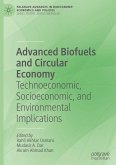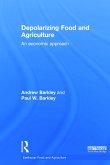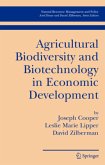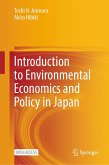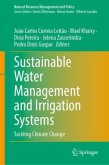Handbook of Circular Bioeconomy
Herausgegeben:Zilberman, David; Zhuang, Jie; Wesseler, Justus; Khanna, Madhu
Handbook of Circular Bioeconomy
Herausgegeben:Zilberman, David; Zhuang, Jie; Wesseler, Justus; Khanna, Madhu
- Gebundenes Buch
- Merkliste
- Auf die Merkliste
- Bewerten Bewerten
- Teilen
- Produkt teilen
- Produkterinnerung
- Produkterinnerung
The book aims to facilitate the development of circular bioeconomy education, research, policy, and engineering practices in global communities to benefit undergraduate and graduate students and professionals. The book is expected to guide future farming activities, reshape urban-rural relationships, promote economic regeneration, and improve science-based regulations and policies to ensure socio-demographic justice and resilience in climate-vulnerable communities. The book will stimulate the investment in new natural resource-based industries and contribute to addressing the challenges of…mehr
Andere Kunden interessierten sich auch für
![Energy Transformation in Lithuania Energy Transformation in Lithuania]() Mantas SvazasEnergy Transformation in Lithuania23,99 €
Mantas SvazasEnergy Transformation in Lithuania23,99 €![Advanced Biofuels and Circular Economy Advanced Biofuels and Circular Economy]() Advanced Biofuels and Circular Economy151,99 €
Advanced Biofuels and Circular Economy151,99 €![Depolarizing Food and Agriculture Depolarizing Food and Agriculture]() Andrew BarkleyDepolarizing Food and Agriculture196,99 €
Andrew BarkleyDepolarizing Food and Agriculture196,99 €![Agricultural Biodiversity and Biotechnology in Economic Development Agricultural Biodiversity and Biotechnology in Economic Development]() Joseph CooperAgricultural Biodiversity and Biotechnology in Economic Development153,99 €
Joseph CooperAgricultural Biodiversity and Biotechnology in Economic Development153,99 €![Consumer Perceptions and Food Consumer Perceptions and Food]() Consumer Perceptions and Food167,99 €
Consumer Perceptions and Food167,99 €![Introduction to Environmental Economics and Policy in Japan Introduction to Environmental Economics and Policy in Japan]() Toshi H. ArimuraIntroduction to Environmental Economics and Policy in Japan38,99 €
Toshi H. ArimuraIntroduction to Environmental Economics and Policy in Japan38,99 €![Sustainable Water Management and Irrigation Systems Sustainable Water Management and Irrigation Systems]() Sustainable Water Management and Irrigation Systems136,99 €
Sustainable Water Management and Irrigation Systems136,99 €-
-
-
The book aims to facilitate the development of circular bioeconomy education, research, policy, and engineering practices in global communities to benefit undergraduate and graduate students and professionals. The book is expected to guide future farming activities, reshape urban-rural relationships, promote economic regeneration, and improve science-based regulations and policies to ensure socio-demographic justice and resilience in climate-vulnerable communities. The book will stimulate the investment in new natural resource-based industries and contribute to addressing the challenges of climate change, nutrition security, biodiversity conservation, and realization of the net zero emission goal.
This book is open access.
This book is open access.
Produktdetails
- Produktdetails
- Natural Resource Management and Policy 61
- Verlag: Springer / Springer Nature Switzerland / Springer, Berlin / UC Berkeley
- Artikelnr. des Verlages: 89512370, 978-3-032-07111-8
- Seitenzahl: 630
- Erscheinungstermin: 31. Dezember 2025
- Englisch
- Abmessung: 235mm x 155mm
- ISBN-13: 9783032071118
- ISBN-10: 3032071119
- Artikelnr.: 75272148
- Herstellerkennzeichnung
- Springer-Verlag GmbH
- Tiergartenstr. 17
- 69121 Heidelberg
- ProductSafety@springernature.com
- Natural Resource Management and Policy 61
- Verlag: Springer / Springer Nature Switzerland / Springer, Berlin / UC Berkeley
- Artikelnr. des Verlages: 89512370, 978-3-032-07111-8
- Seitenzahl: 630
- Erscheinungstermin: 31. Dezember 2025
- Englisch
- Abmessung: 235mm x 155mm
- ISBN-13: 9783032071118
- ISBN-10: 3032071119
- Artikelnr.: 75272148
- Herstellerkennzeichnung
- Springer-Verlag GmbH
- Tiergartenstr. 17
- 69121 Heidelberg
- ProductSafety@springernature.com
Dr. David Zilberman is a Distinguished Professor of Agricultural and Resource Economics at UC Berkeley. He received the 2019 Wolf Prize in Agriculture and was elected a member of the U.S. National Academy of Science in 2019. David served as the 2018-19 President of the Agricultural & Applied Economics Association (AAEA). He's a fellow of multiple professional associations and has published in professional and popular outlets. He has over 400 referenced journal articles ranging from Science to ARE-Update and has edited 30 books. In addition, he has served as a Consultant to the U.S. Environmental Protection Agency, USDA, the World Bank, FAO, MARS, BP, WWF, Shell and others. David got a BA from Tel Aviv University and a Berkeley Ph.D. David co-founded the Beahrs Environmental Leadership Program, the International Consortium of Applied Bioeconomy Research and is the founder and academic director of the Berkeley MDP program. David's research analyzes water, innovation, supply chain, agriculture, energy, and the environment. He has researched the economics and political economy of COVID-19 and of agricultural biotechnology, and the potential of the bioeconomy. During the last two years he has studied the economics and supply chain design of Black Soldier Fly waste management systems. Dr. Jie Zhuang is a professor in Department of Biosystems Engineering and Soil Science, director of environmental and soil science graduate studies, and the lead of university cluster hire initiative of resilient agriculture and forest systems at the University of Tennessee (UT) in Knoxville, Tennessee, USA. He is also an advisory council member of UT Institute of Agriculture and an affiliated faculty of UT Institute for a Secure and Sustainable Environment and the Institute of Energy and Environment. He has served on numerous award committees of scientific organizations and proposal review panels of national and international funding agencies. Dr. Zhuang's research topics range from fate and transport of contaminants (such as virus, bacterium, organic chemicals, metals, engineering colloids, and nutrients) to soil hydrological modeling, crop-water relations, carbon-water-nutrient interactions, food-energy-water nexus, and circular food systems. He links environmental soil science to food-energy-water nexus by innovating solutions for soil restoration and resilience, safe reclaimed water irrigation, and regenerative agriculture. He has published ~170 refereed articles and book chapters and ~100 conference abstracts. His current research projects aim to develop climate-smart food-energy-water nexus on smallholder farms. Dr. Justus Wesseler is a professor and chairholder of Wageningen University, The Netherlands. holds the Agricultural Economics and Rural Policy chair at Wageningen University, the Netherlands. He has a degree in agricultural, environmental, and natural resource economics from the University of Göttingen, Germany. His research work is on bioeconomy economics and policies. The primary focus is on the contribution of value chains to improve sustainability and the impact of new technologies and regulations on the value chain in this respect. His research work has been widely published in peer-reviewed journals and books. He is the past-president of the International Consortium of Applied Bioeconomy Research (ICABR). He has been involved in many small and large-scale international research projects as a team member and/or coordinator. He has been invited to serve as an adviser in academia and research, including the European Commission, the German Federal Ministry of Agriculture, Food, and Community, and the German Science Council. Dr. Madhu Khanna is the ACES Distinguished Professor of Environmental Economics in the Department of Agricultural and Consumer Economics and Alvin H. Baum Family Chair and Director of the Institute for Sustainability, Energy, and Environment, at the University of Illinois at Urbana-Champaign. She received her Ph.D from the University of California, Berkeley. Her research is at the intersection of agricultural, energy and environmental economics. She has served on the USEPA Science Advisory Board for 10 years and as a Chair/member of panels and advisory committees for NIFA, USEPA and NSF and the National Academy of Sciences. She has also served on the Board of Directors of the Agricultural and Applied Economics Association (AAEA) and the Association of Environmental and Resource Economists (AERE). She is a University of Illinois Scholar, a Stanford Woods Institute of Environment Leopold Leadership Fellow, AAEA Fellow and AAEA past President, and fellow of the European Association of Environmental and Resource Economists (EAERE) and member of the Board of Directors of the International Association of Agricultural Economics.
.- Part I: Strategies and Impacts of a Circular Bioeconomy.
.- What is the Bioeconomy and How Does It Make a Difference? An Introduction.
.- Circular Bioeconomy Systems: A Path Towards a Sustainable Future.
.- Building A Better Bioeconomy from The Ground Up.
.- Building Supply Chains to Create a Climate-Smart Bioeconomy.
.- Bioeconomy, Agriculture, and The Circular Economy: Opportunity and Challenges Lessons Learned from The EU Biomonitor Project.
.- Circular Bioeconomy Principles, Implementation, and Policy Framework.
.- Regenerative Agriculture Bioeconomy: A Concept Facilitating Transition from Circular to Regenerative Systems.
.- The Bioeconomy and Historically Underserved Communities.
.- The Circular Bioeconomy: Concepts, Opportunities, and Limitations.
.- Incorporating Circular Bioeconomy into The Sustainable Development of Small Farms in The United States.
.- Alternative Bioeconomy Strategies for Decarbonization.
.- Part II: Technologies for a Circular Bioeconomy.
.- Diversifying Agriculture, Protecting the Environment, Stabilizing Economies: The Story of The Black Soldier Fly.
.- Climate-Smart Technologies and Food Security in the Context of a Circular Bioeconomy from Adaptation and Resilience to Mitigation.
.- Feedstock Choices for Advancing the Bioeconomy in the US and Policy Implications.
.- Biotechnology and Microbial Genomics for Circular Bioeconomy.
.- Plastic Pollution: Challenges and Strategies.
.- Circular Bioeconomy Toward Net-Zero Urban Systems by Food-Energy-Water Nexus Approach.
.- Impacts of Progress of Artificial Intelligence on Circular Bioeconomy: Applications, Challenges, and Future Directions.
.- One Health-Centric Circular Bioeconomy.
.- Amplifying a Macroalgae Bioeconomy.
.- Bioenergy for Inclusive and Sustainable Economic Growth.
.- Part III: Circular Bioeconomy Practices in Latin America and Around the World.
.- China s Bioeconomy Transition: A Policy Framework.
.- Circular Bioeconomy of Argentina's Fruit and Vegetable Agroindustry.
.- The Case of Sustainable Dairy Production Model.
.- Circular Sociobioeconomy: Collaborative Governance and Grassroots Innovation for Sociobiodiversity Products in the Amazon.
.- Promoting Circular Economy in an Argentinean Producers Network.
.- Forest-based Amazonian Bioeconomies: New Opportunities and Old Challenges.
.- Sugarcane Bioeconomy and Circularity in Latin America: Progress and Future Pathway.
.- What is the Bioeconomy and How Does It Make a Difference? An Introduction.
.- Circular Bioeconomy Systems: A Path Towards a Sustainable Future.
.- Building A Better Bioeconomy from The Ground Up.
.- Building Supply Chains to Create a Climate-Smart Bioeconomy.
.- Bioeconomy, Agriculture, and The Circular Economy: Opportunity and Challenges Lessons Learned from The EU Biomonitor Project.
.- Circular Bioeconomy Principles, Implementation, and Policy Framework.
.- Regenerative Agriculture Bioeconomy: A Concept Facilitating Transition from Circular to Regenerative Systems.
.- The Bioeconomy and Historically Underserved Communities.
.- The Circular Bioeconomy: Concepts, Opportunities, and Limitations.
.- Incorporating Circular Bioeconomy into The Sustainable Development of Small Farms in The United States.
.- Alternative Bioeconomy Strategies for Decarbonization.
.- Part II: Technologies for a Circular Bioeconomy.
.- Diversifying Agriculture, Protecting the Environment, Stabilizing Economies: The Story of The Black Soldier Fly.
.- Climate-Smart Technologies and Food Security in the Context of a Circular Bioeconomy from Adaptation and Resilience to Mitigation.
.- Feedstock Choices for Advancing the Bioeconomy in the US and Policy Implications.
.- Biotechnology and Microbial Genomics for Circular Bioeconomy.
.- Plastic Pollution: Challenges and Strategies.
.- Circular Bioeconomy Toward Net-Zero Urban Systems by Food-Energy-Water Nexus Approach.
.- Impacts of Progress of Artificial Intelligence on Circular Bioeconomy: Applications, Challenges, and Future Directions.
.- One Health-Centric Circular Bioeconomy.
.- Amplifying a Macroalgae Bioeconomy.
.- Bioenergy for Inclusive and Sustainable Economic Growth.
.- Part III: Circular Bioeconomy Practices in Latin America and Around the World.
.- China s Bioeconomy Transition: A Policy Framework.
.- Circular Bioeconomy of Argentina's Fruit and Vegetable Agroindustry.
.- The Case of Sustainable Dairy Production Model.
.- Circular Sociobioeconomy: Collaborative Governance and Grassroots Innovation for Sociobiodiversity Products in the Amazon.
.- Promoting Circular Economy in an Argentinean Producers Network.
.- Forest-based Amazonian Bioeconomies: New Opportunities and Old Challenges.
.- Sugarcane Bioeconomy and Circularity in Latin America: Progress and Future Pathway.
.- Part I: Strategies and Impacts of a Circular Bioeconomy.
.- What is the Bioeconomy and How Does It Make a Difference? An Introduction.
.- Circular Bioeconomy Systems: A Path Towards a Sustainable Future.
.- Building A Better Bioeconomy from The Ground Up.
.- Building Supply Chains to Create a Climate-Smart Bioeconomy.
.- Bioeconomy, Agriculture, and The Circular Economy: Opportunity and Challenges Lessons Learned from The EU Biomonitor Project.
.- Circular Bioeconomy Principles, Implementation, and Policy Framework.
.- Regenerative Agriculture Bioeconomy: A Concept Facilitating Transition from Circular to Regenerative Systems.
.- The Bioeconomy and Historically Underserved Communities.
.- The Circular Bioeconomy: Concepts, Opportunities, and Limitations.
.- Incorporating Circular Bioeconomy into The Sustainable Development of Small Farms in The United States.
.- Alternative Bioeconomy Strategies for Decarbonization.
.- Part II: Technologies for a Circular Bioeconomy.
.- Diversifying Agriculture, Protecting the Environment, Stabilizing Economies: The Story of The Black Soldier Fly.
.- Climate-Smart Technologies and Food Security in the Context of a Circular Bioeconomy from Adaptation and Resilience to Mitigation.
.- Feedstock Choices for Advancing the Bioeconomy in the US and Policy Implications.
.- Biotechnology and Microbial Genomics for Circular Bioeconomy.
.- Plastic Pollution: Challenges and Strategies.
.- Circular Bioeconomy Toward Net-Zero Urban Systems by Food-Energy-Water Nexus Approach.
.- Impacts of Progress of Artificial Intelligence on Circular Bioeconomy: Applications, Challenges, and Future Directions.
.- One Health-Centric Circular Bioeconomy.
.- Amplifying a Macroalgae Bioeconomy.
.- Bioenergy for Inclusive and Sustainable Economic Growth.
.- Part III: Circular Bioeconomy Practices in Latin America and Around the World.
.- China s Bioeconomy Transition: A Policy Framework.
.- Circular Bioeconomy of Argentina's Fruit and Vegetable Agroindustry.
.- The Case of Sustainable Dairy Production Model.
.- Circular Sociobioeconomy: Collaborative Governance and Grassroots Innovation for Sociobiodiversity Products in the Amazon.
.- Promoting Circular Economy in an Argentinean Producers Network.
.- Forest-based Amazonian Bioeconomies: New Opportunities and Old Challenges.
.- Sugarcane Bioeconomy and Circularity in Latin America: Progress and Future Pathway.
.- What is the Bioeconomy and How Does It Make a Difference? An Introduction.
.- Circular Bioeconomy Systems: A Path Towards a Sustainable Future.
.- Building A Better Bioeconomy from The Ground Up.
.- Building Supply Chains to Create a Climate-Smart Bioeconomy.
.- Bioeconomy, Agriculture, and The Circular Economy: Opportunity and Challenges Lessons Learned from The EU Biomonitor Project.
.- Circular Bioeconomy Principles, Implementation, and Policy Framework.
.- Regenerative Agriculture Bioeconomy: A Concept Facilitating Transition from Circular to Regenerative Systems.
.- The Bioeconomy and Historically Underserved Communities.
.- The Circular Bioeconomy: Concepts, Opportunities, and Limitations.
.- Incorporating Circular Bioeconomy into The Sustainable Development of Small Farms in The United States.
.- Alternative Bioeconomy Strategies for Decarbonization.
.- Part II: Technologies for a Circular Bioeconomy.
.- Diversifying Agriculture, Protecting the Environment, Stabilizing Economies: The Story of The Black Soldier Fly.
.- Climate-Smart Technologies and Food Security in the Context of a Circular Bioeconomy from Adaptation and Resilience to Mitigation.
.- Feedstock Choices for Advancing the Bioeconomy in the US and Policy Implications.
.- Biotechnology and Microbial Genomics for Circular Bioeconomy.
.- Plastic Pollution: Challenges and Strategies.
.- Circular Bioeconomy Toward Net-Zero Urban Systems by Food-Energy-Water Nexus Approach.
.- Impacts of Progress of Artificial Intelligence on Circular Bioeconomy: Applications, Challenges, and Future Directions.
.- One Health-Centric Circular Bioeconomy.
.- Amplifying a Macroalgae Bioeconomy.
.- Bioenergy for Inclusive and Sustainable Economic Growth.
.- Part III: Circular Bioeconomy Practices in Latin America and Around the World.
.- China s Bioeconomy Transition: A Policy Framework.
.- Circular Bioeconomy of Argentina's Fruit and Vegetable Agroindustry.
.- The Case of Sustainable Dairy Production Model.
.- Circular Sociobioeconomy: Collaborative Governance and Grassroots Innovation for Sociobiodiversity Products in the Amazon.
.- Promoting Circular Economy in an Argentinean Producers Network.
.- Forest-based Amazonian Bioeconomies: New Opportunities and Old Challenges.
.- Sugarcane Bioeconomy and Circularity in Latin America: Progress and Future Pathway.



